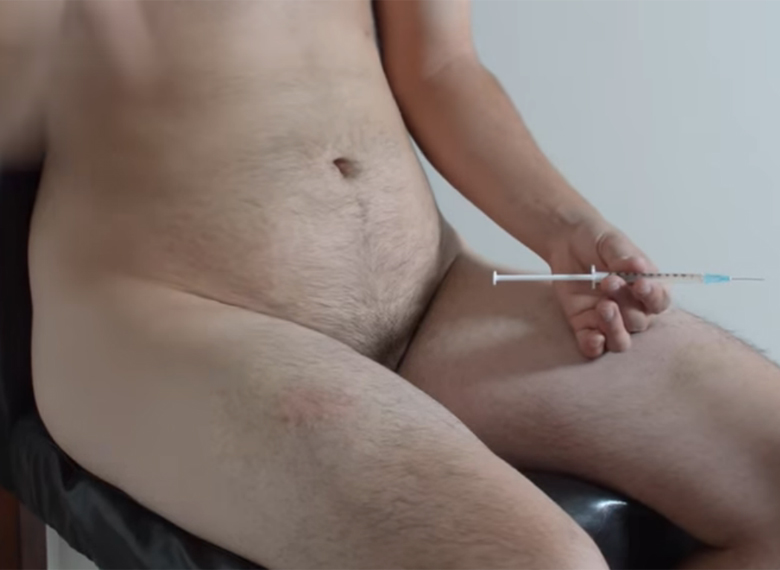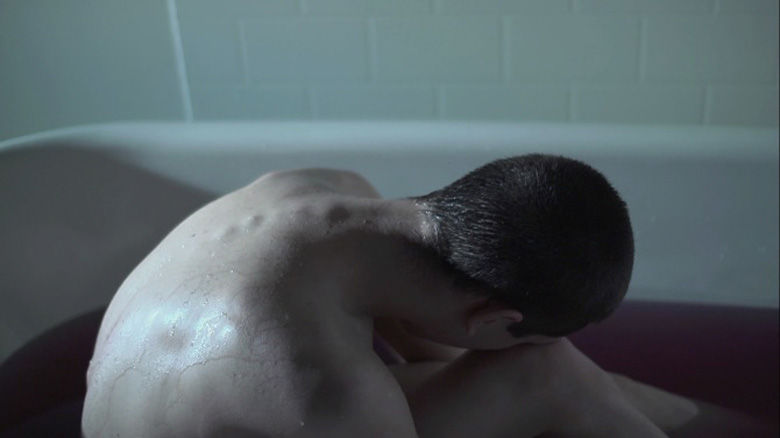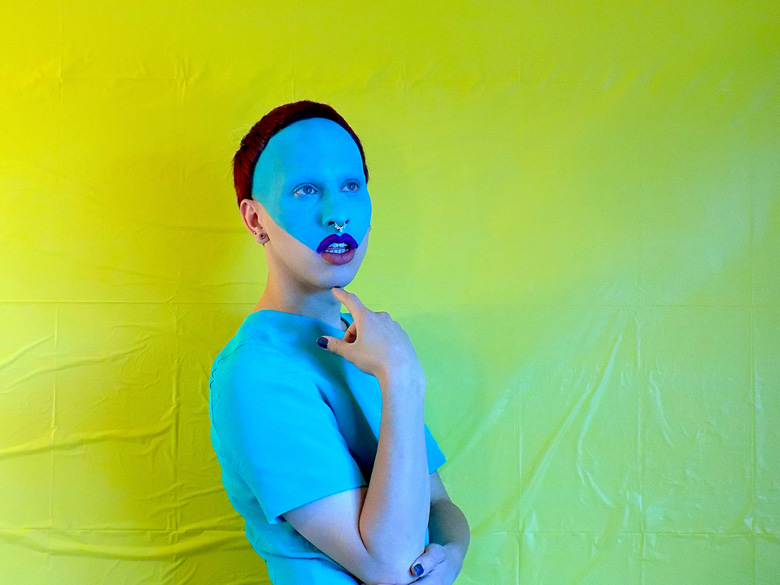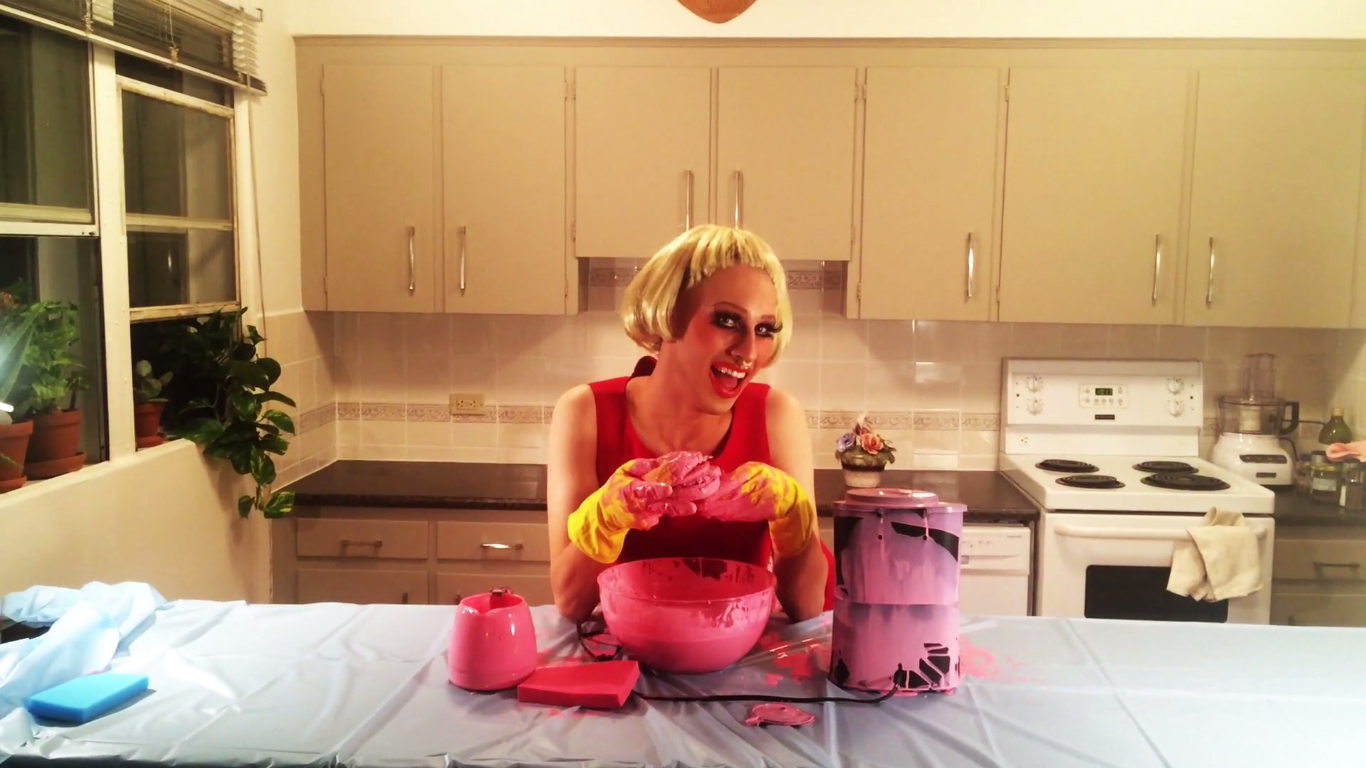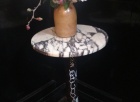“Can film and media work sustain the complexity of queer experience that the flat, representational, often naturalistic, image has difficulty with?"
This interview was held on January 5th, 2017 in Calgary, Alberta, and has been edited for length.
ANGELA FERMOR: So my name’s Angela Fermor, I’m an emerging artist based in Calgary, Alberta and I’m here with two other emerging artists from Calgary: Nine Kennedy—
NINE KENNEDY: Hello
AF: —and Dan McCartney.
DAN MCCARTNEY: Hello.
AF: Uh, so what we’re going to be talking about is the iconography and token imagery of the queer body and the artistic representations of the queer experience. Um, I think I can speak for all of us, um, when I say that we’re all here because we’re interested in starting a conversation.
NK: Mhm.
AF: I guess in our personal communities, um, about how the queer form and the experience are being represented. Um, and that’s, like, inclusive of our own practices, um, and that of our peers, and I guess even like our mentors? Um, so this conversation is going to be us inquiring about what is and what isn't being talked about, and what’s being assumed, and how are we communicating our experience, and what does it mean to communicate genuinely in a queer art practice. And this will, uh… hopefully culminate into a continued interrogation of the queer image, or the token image of the queer body or experience. . . Um, do you guys have—wanna start that or… I can start it too.
NK: I’ll start! For sure. So…
AF: So, like, when I say, like, ‘tokenized’…
NK: My understanding of tokenism is including people just for the sake of... including people.
AF: Oh, kay.
NK: So, it’s not an inclusive act based out of genuine, um, collaboration or a genuine joining of groups but really it’s just saying, ‘Here’s a minority, we’re including you to show that we are including a minority’—
AF: Oh, interesting. Oh, yeah.
NK: —so, that’s how I approach the definition of tokenism.
AF: Right, okay.
DM: I would say… yeah, definitely similar. Especially with being Métis, people only want you in for a certain reason: because they then need their token person, their token minority—
AF: Right.
DM: And there, that space is important, but, like, it still feels like a little bit of a backhand too.
AF: Right.
DM: Because you wouldn’t ask me to do this because of the merit of my work, but it’s just because it’s checking off something—
AF: Exactly. Right.
DM: —which is super problematic for a lot of reasons.
Something that I sort of see tokenism as... it exploits almost a popular visual language in order to create a general image for what is actually a really, really large group of people.
AF: So, like, I guess like, the sort of, the thing that I specifically wanna talk about is… like, what do you have to fulfill in order to be that thing that is being checked off. Like, what is that personality, or character, or whatever—
DM: [Laughing] Okay, okay. Yeah, yeah.
AF: —Do you know what I mean, like, what is that? And what language is created around that?
DM: Um…
AF: So like, um, I guess, like, that something that I sort of see tokenism as is, it’s sort of like, um… it exploits almost a popular visual language, um, in order to create a general image for what is actually, like, a really, really large group of people. Um… so like, when you’re tokenizing someone, you’re using that image of that personality or that character, um, that’s been assigned to what is really a large group of people, and then you’re putting them inside the box of that character. Um, so then when we’re talking about a token image in art, we’re talking about what is the token representation of, um, and this specifically in this interview we’re going to be talking about what is this token imagery of the queer body or the queer experience. So that actually goes really, really well into what you two just said because, like, what is the thing—like, the representation of a queer body that will check off that list. Um, and for me, I think that that image, yeah, is the nude queer form. Very specifically the nude body. Um, and I think that’s especially prevalent, um, in conversations about trans folk and gender queer people as well—
DM: Mhm.
AF: —that in order to sort of validate the conversation of like a gender queer or trans body, there has to be nudity involved.
NK: Hm.
AF: Um…
DM: Which is something I’ve struggled with for the past four years. Five years! Yeah, for sure. Cuz, that’s a huge issue I have. Something I wrestle with every time I make art, so.
AF: Yeah. So like, why do you wrestle with it? Like—
DM: Because—
AF: —why do you think it’s problematic?
DM: —for me, um, it upsets me. It seems as if the only time, uh, people take my art seriously is if I’m crying or naked.
AF: Oh, yeah.
DM: And they love the combination of the two, and it’s like—
AF: Right, yeah.
DM: —if I only, like, make work that doesn't have that in it, it gets, uh, less feedback. It doesn't give people that, like, visceral reaction to it. It doesn’t, like, feed into what they think trans-ness should be. Especially being First Nations as well, like, people just really wanna dig deep into the sorrow and the pain without—
AF: Yeah! We’ve talked about that.
DM: —without, yeah, without ever actually ever wanting to get to know the actual human. They just want the image, for sure.
AF: Yeah. That sort of like, token…
DM: Stoic, sad, Indian boy who is now a man. That’s exactly what they want.
AF: Yeah, and then they also want that sad story of the-body-that-is-not-wanted.
DM: Exactly. Which is…
AF: You know, they can’t—that’s—and like…I don’t know—
DM: It’s exploitative, for sure.
NK: It’s exploitative and they, um, a lot of times audience want to be sensationalized—
AF: Yeah, good point, yeah.
NK: —so that’s why they not only react to images like that, but crave and expect images like that—
AF: Yeah.
NK: —and will not take artwork seriously that isn't expressing that because that’s what— y’know, um—people who aren’t that identity have been taught, um, by the media and by, um, general culture, like, that’s what, y’know, to be trans means: to hate your body. Um, so if artwork doesn’t represent that, they really don't have that pre-learned connection—
AF: Yes, definitely.
NK: —that they can then identify with. So tokenization also kind of relates back to—it’s always that sensationalized, first impressions, like, snap judgement of a person that you can make.
AF: Yeah, yeah. Definitely.
NK: Because personally my work doesn’t deal with nudity a lot, but I feel like I get tokenized because, in my drag performances, I do a lot of very flamboyant, high colours, pinks, blues, like, um, very exaggerated drag forms, and I feel like people need that to click, like, ‘Oh! I guess this person’s queer. Look what they look like.’
AF: Okay, yeah.
NK: Um, and I feel like that’s the same way: they sensationally—that’s how they see a flamboyant queer person to act, so if my artwork doesn't express that—
AF: Right.
NK: —they’re not as receptive.
I’m not trying to express any gender that I am or am not; I’m more trying to express an exaggerated, kind of ironic performance of what we take to be a queer identity.
AF: Have you ever had it when you’re doing—like, I don’t know how you refer to them: as like a ‘look’ or as an ‘outfit,’ as a character, or just…
NK: I would say all of the above.
AF: All of the above—
NK: Yes.
AF: —okay, so like when—
NK: A stream of consciousness—
AF: [Laughing]
NK: —‘durational experience,’ I would say.
AF: Okay! So when you’re getting ready for those, do you ever have a point where you’re, like, deciding … entryway points? Of like, ‘Is this gonna look like I’m in drag enough? Or is this just gonna look like I’m gonna scare the shit out of people,’ or…
NK: Those all come into play, I think, when I do my work, but at the same time, I want to do more, you know… uh, deconstructing of drag, which is a lot of my practice that’s not necessarily stereotypical, historical drag practices of, ‘I am this gender—
AF: Exactly, yeah.
NK: —and I am going to look like the other gender.’ Um, you know, as I come from it as a non-binary person, I’m not trying to express any gender that I am or am not; I’m more trying to express an exaggerated, kind of ironic performance of what we take to be a queer identity.
AF: Yeah, right. So like, because, like, there is also, like, a stereotype of drag, right?
NK: Yes.
AF: And of, like, what that should be. And so like, people who have had no contact with like, drag or with like, the queer community, um, you know, do you ever have—do you ever make decisions, as an artist, based on those people? Do you feel like, ‘Oh I need to look more like this stereotype image so that my work can be, perhaps more accessible? Or…
NK: No.
AF: [Laughter]
NK: I don’t. But I do feel like sometimes I get invited to participate in events because of that nature.
AF: Mmm, okay.
NK: Because they want, I would say, they want, um, people that can be easily noticed at their shows. Or, you know, pieces that are like, ‘Look at this interesting minority identity that I have going on.’
AF: Yeah, exactly.
DM: ‘That we’ve collected…’
NK: Yes.
AF: ‘That ticks off the box that we need.’
NK: Yeah, exactly.
AF: Yeah, definitely. Yeah, I guess, I kind of explained my position, and sort why I’m asking these questions. Um, I come from a practice based almost entirely in non-representational images and works. Um, I don't include the human form in my work. Or at least, like, I very, very rarely do and haven’t for a long time. Um, so the works are often, instead, characterized by the act of mark making; so, specifically making one mark over and over again, hundreds of times. So these acts, or these marks, each represent one moment of me placing, like, pen to page or brush to canvas, um, and ultimately each represent a moment of my time, like real time. Um, so they’re documents of process, of experience, of an actual lived experience. Um… but I believe because they’re non-representational, um, like—the series of marks just kind of like, they sort of gather; they never really turn into something, like, nameable or identifiable, um, and so I think because of that it’s kind of like, up for debate whether or not there is something about them that makes them “queer” or not. Because they’re non-representational, what queer language is there, anymore, what like tokenized language is there anymore? Um, and like, I don't even think there’s necessarily anything about the materiality of my work either that makes it queer—because I just use canvas, ink, and charcoal mostly. Um… so, I guess like, in an artwork, if there isn’t any queer visual history, iconography, or token imagery, etcetera, being directly referenced, there’s no, like, colour-coding, or I guess glitter coding, pink washing, whatever term we wanna use—
NK: [Laughs]
AF: —connecting these works to queer identity, are they queer? Do you think that they are they made queer by virtue of the fact that I identify as queer?
DM: I would say so, yes.
AF: What do you, like, what do you think about, like—[laughs]
DM: Well like, the person who created it is all about your space and mark in time, and then it can’t escape the fact that it’s queer, because you are queer and that’s proof of existence that a queer person was here—
AF: Right.
DM: —and it might not be a statement, like of, like of glitter—like of glitter, like ‘Hello! Queer!’ but it stills exists and it’s still just as relevant as if it was a big glitter… whatever, you know what I mean? Like, it just…
AF: Right, but then there’s like, the, sort of like question—like, I’m-I’m very confidant in like, how I’m representing myself in my practice. I’m—I guess though, like, no one ever looks at my work and says like, ‘Queer Art!’ points at it and says, ‘That’s queer,’ which I am neither here nor there about, but, as an artist, I think it’s about making decisions and… I’m wondering whether or not I’m—if I’m making a decision that is representative of who I am anymore. If, if I’m sort of like feeling the pressure to create some kind of accessible narrative for my work—
DM: Mhm.
AF: —so that people may know that that’s a conversation that going on in my life, and in my work. And so I’m wondering, for the non-representational image, how do you present a queerness about it? That is—but also like, avoid that really generalized, problematic, token visual language? Do you guys ever have problems in your own practice where you debate, you have that inner debate of being both an artist and both a queer person?
NK: For sure. Yeah. I think a lot times in my own practice I kind of like, ‘Am I not really showing what I want to,’ and a lot of the times it is like, an alternative queer identity. But at the same time, um, I’m reassured by the sense that it doesn't always have to be immediately identifiable by a complete stranger who has no—
AF: Mhm.
NK: —previous knowledge of myself or my work, that it’s queer. That’s not, to me, what defines a piece as queer. Um, you have to, you know, further engage with the piece, further engage with the artist to truly understand the work, just as itself, in any piece of work. And then from there you could extrapolate the queerness from any art piece—representational or non-representational. Like, I also really feel strongly that queer is just not, like, a noun of like, attraction. Queer is very much a verb to me. Queer is very much the process I take in terms of how I react and, you know, deconstruct my own identity, and I—you know, um—critique how I perform in various, you know, spaces as, you know, an interior designer and an artist. I very much look at, um, when it comes to ‘what is a queer space?’ it’s never really necessarily the physical space but it’s how people act in it and, you know, the energies people give off in the way we manipulate certain interior elements, um, to suit our own needs. Um, so I feel like being non-representational does not take away the queerness of anyone’s work, um, maybe it just invites more investigation, it invites more conversations…to happen.
AF: Mhm. Yeah, yeah. Um, so I guess—yeah—the reason that I want to specifically ask you two about this topic is because of your experiences with film and media art. So, I’m coming from a place where, like, I made a decision to go to the non-representational, um, because I’m pessimistic about the ability of a representative [laughs] or naturalistic image, um, being able to express the complexity that is the queer experience, right? Um, I went to abstraction, then to non-representation—I think it was like, my second year at ACAD?—um, so that I could sort of like put to image, or to canvas I guess, like the open-endedness of being queer. Really what being queer feels like to me is like… not knowing anything, I guess? Um, so like, when I came out, technically, yeah, I said the words “I’m gay,” but really what I was saying to people was, “I don’t know what I am!” And that’s enough for me to be alternative in some way and to have to like, ‘come out’ about it.
NK: For sure.
AF: Um, but really, out of the like, huge lexicon of words that we have—that we’re able to choose from now—um, I don’t really identify with any of them. But being queer to me, instead—instead of like determining labels and like choosing which label fits you—it really, for me, feels like an on-going series of questions.
NK: Mhm.
AF: And so in my work, if I’m going to document my queer experience, then I need to document that sort of lack of knowing. And so that’s why, um… non-representative is just as important to me? Um… that sort of, yeah, that lack of concrete-ness is essential and, um…
NK: I think it’s important to note that, you know, for myself, you know, being queer and identifying with that—it’s always about, for me, questioning. It’s never like—you know, queer was not a destination, queer was a journey—
AF: Yeah.
NK: —and continues to be that. And I think, with your work, and practicing with non-representation, about mark-making, and documenting time, it speaks to that notion of journey of not knowing, of always asking questions and, you know, not necessarily arriving at answers. And being okay with that, and that’s, you know, not, um, a conclusion you’re necessarily striving for, so—
AF: Right.
NK: —people who understand that, or people who will, you know, take the time to engage with that and learn about that and ask questions, can extrapolate that, you know, that non-representational work can be queer, based on the methodology that goes into it.
Queer is very much a verb to me.
AF: Yeah, absolutely. I think that happens… often in your work as well. I mean, we’re not necessarily talking about the—I’m not talking about the film and media work that you’ve made, Dan, but, um, the collage work that you’ve done. You can see the time that’s put into it—there’s an actual material representation of that. Um…
DM: And if, yeah—sorry—if people don't necessarily know that it’s queer, hopefully, yes, they would engage with it long enough to realize that there’s something there they don't understand—
AF: Mhm.
DM: —because they perhaps themselves are not queer, and perhaps its the same for your work as well.
AF: Yeah, absolutely.
DM: It’s still queer. They might not recognize it, you know, another queer person might not recognize it right away. But if they spend enough time with it, perhaps there’s something there, that un-knowing would really resonate with them too. So, just wanted to say that, yeah.
AF: Mhm. So I guess this moves us into this—yeah the second part of the conversation—which is almost an answer to the first interrogation or investigation of the token queer image because, in light of both your practices, um, and like the content of the magazine that we’re doing this interview for, I want to specify the possibilities of representation of the queer experience in film and media work.
And, like I’ve said previously, um, I create work that is non-representative and the reason that I choose to do so is I believe that you almost need an abstraction in order to break up those standardized forms of visual recognition, such as token imagery, um, in order to be able to provide access to the complexity, or the unknowingness, that is actually involved in being queer.
Um, so after researching, and watching some film and media work, and actually, specifically film and media work from both of your practices, I now want to ask the question, like, well, can film—can film and media be…um, the medium that can sustain the complexity of queer experience that that flat, perhaps representational, or even naturalistic image, cannot? Uh, because from the works and collaborations of yours that I’ve seen, there’s so much opportunity to just… like, move, I guess? To move through a dialogue, to move through the topic of queerness, but — like, because the image now, literally is a moving image, right? Because of that, it already has a complexity. It has a complexity of growth, of narrative, perhaps of sound, and now it has all these available options. So, I guess my question would be, for both of you, what do you think happens in the making of film and media work, that can provide an alternative to that flat tokenized image?
DM: Um, I think for me, uh especially, uh, with the First Nations aspect of it, that fact is that—and it’s very similar to how queer people throughout history did portraiture and they represented themselves, uh, by themselves, for themselves, and for others. It’s the same with the First Nations side because like a hundred years ago—not even—the only photographs of us, definitely no videos, would have been in residential schools—
AF: Mhm.
DM: —so I think it’s awesome and such like a tool of reclaiming that image of us, instead of like, in the textbooks where the token Injun Joe or like, stoic Indian, and so like, the fact that I can create something that moves and just takes up space in a way that wasn’t possible, like, to just really reclaim something that twenty years ago like I probably wouldn't have has access to. ‘Cause like, within twenty years or more there was still residential schools, so I’m thinking all of about these things and how, yeah, it does link back to my queerness—
AF: Mhm.
DM: —so, I just find like, there’s something so immediate and um, just it grabs people’s attention a lot easier which, for me, it kind of takes a stress off of me ‘cause then I don't have to think about like, ‘Okay, how—how do I make them, how do I grab their attention—
AF: Right.
DM: —or even stay long enough to look at my collages because they’re very detail-oriented. Can I take those details and still apply them to a short video which people can loop back to over and over again.
AF: Right. Interesting. And so like, you sort of activate the—yeah, the flat image. And so like, the second that you activate…Yeah, what is the flat representation of, like, a tokenized image or body, it’s almost no longer that thing at all. It can’t sustain itself anymore because you can't help but keep watching the video or sort keep engaging with it, and the second that you engage it beyond that surface level, is the second that you find the complexity of the narrative.
DM: Yes, I would say that. Because on first glance people would be like, ‘Why is he naked?’ like, ‘Is he just being another stoic Indian?’
AF: Exactly. Yep.
DM: And it’s like, well no, if you keep watching—which people usually do—then that’s when the details come apart and then it’s like dissecting it as well.
AF: Hm, and so this is the work that you recently showed for EMMEDIA, right?
DM: Yeah, at AlterNATIVE. It’s called Mothering Myself. Yep.
AF: Um, and then, Nine, like, in your—cause you’ve acted or starred in like, so many films it looks like—
NK: I try.
AF: —and like, you’ve created some for yourself. You did one for the Youth Queer Film Media? Is that...?
NK: Yeah the Youth Queer Media Program, put on by Fairytales Film Festival. I was in their program in… 2004… was when I did my piece.1
AF: Was it really 2004?
NK: Yeah, it was a long time ago.
AF: Oh wow.
NK: I know, strange. But yeah, I’ve also starred in a lot of collaborations with friends, specifically um, friends such as Felix Tuba, Khrysta Lloren, and another collective here in Calgary called BabyGurl$. Um, for me, film, um, has this wonderful opportunity because it has, like, this sense of time, um, and duration, um, and there’s always, y’know, you’re representing a 3D world within film, it’s—you know, you operate within a space. Um, and I think queer identity, for myself, has a lot to do with performance. You know, ‘Gender is performative, ha-ha-ha’—
[Laughter]
NK: —but, um, film gives you that sense that you can be performative and you can, you know, express a narrative in such a way that is completely your own. And there’s so many opportunities in film, with—not just in, you know, acting and creating a narrative, but in, you know, post-production and editing and sound design and lighting—that, there’s so many elements to it that you can manipulate and interrogate and deconstruct, that really lends itself to, you know, alternative representation and experimentation—
AF: Yeah.
NK: —which I find really interesting. And I also think film, in my own personal practice, is a great time to collaborate with other people because there’s so many different aspects to it.
AF: Oh yeah, absolutely.
NK: It’s hard to, you know, create, like, a painting with twenty other people—
AF: Yeah.
NK: —you know? But when it comes to film there’s so many opportunities to have multiple, you know, people starring, multiple people behind the camera, um—
AF: It’s almost impossible not to have like, a crew at least.
NK: Exactly. Yeah. It’s a really great practice when it comes to community building.
AF: Yeah. Absolutely. So there’s both like, the image that you’re creating, um, and like, the cultural narrative of that, but then just the creation of it as well. Yeah. All of that will lend itself to… at least taking a different avenue away from what is, like, I guess what is a generalized language that is tokenization.
NK: Mhm.
AF: Um, yeah. So, I guess, like…I think it’s really—I think it’s really important for any group of people to be engaged in having conversation about what images they or others use to understand them. Um, and one of the problems that I think with tokenization is that, perhaps an image was created, um, and it’s not necessarily detrimental, but it may have been orig—um, it may have originally been originally intended as a means of accessibility. Um, accessibility—for the viewer, for society, to that person’s or that group’s experience… and so, I guess in regards to accessibility—we’ve kind of already been talking about this—but I think, from the way that you guys have been talking about the film and media work that you’ve been doing, there’s—like, when, when that kind of work is presented to you there is the narrative that is sort of within the work itself, but there is also the narrative of what happened to make it that is almost completely—like, it’s so hard to take it apart from the work itself, right?
NK: Mhm.
AF: Um, so I guess, I guess what I wanna talk about is… creating—are you guys looking to create accessibility through the work itself, as well as the narrative? Do you guys ever specifically include almost like—like, break the fourth wall, or something like that, in the work that you produce in order to create an accessibility that lives beyond the flat image or the work that you’re creating? Would you ever consider making work that actually goes into, like, the personal? I guess? Sorry does that make sense...
NK: Of course! I think that—
DM: I was trying to think about…
[Laughter]
NK: Yeah! I think that all of my work comes from a sense of being personal, and relates to an experience that I go through. And an identity, you know, that I have constructed for myself, and how people react to that. And you know, in senses that I get invited to collaborate with other artists, that they understand where I’m coming from. Um, and I do think that, um, accessibility is important in art, and especially in film—like, um, film is such a universally accepted, um, medium of art that it’s, you know, permeates every aspect of our culture really. Um, a lot of times, like, static representational imagery like, you know, paintings or sculptures, are very much limited to gallery spaces—
AF: Mm.
NK: —Films, you know, can occupy those spaces as well, but also have their own life via, you know, social media, and the internet, and also—
AF: Yeah, they go into your home, your private space...
NK: —They go into your home. And, you know, they’re invited into festivals, so film is great way to get, um, more people engaged, and more people involved, and to be able to show work that you’ve produced in alternative spaces, as well.
AF: Mhm.
NK: And, in terms of breaking the fourth wall, um, I think there’s always opportunities within the work I produce to invite others to, you know, not necessarily engage—not the work that I produce—but also take ideas that they get from it and apply it to themselves. Um, or it invites— I hope it invites—um, people to, um, you know, ask the same questions I’m asking.
AF: Mhm. Yeah. Absolutely.
DM: Mhm. Um, for me, I would say definitely, uh, all of my work is extremely personal. Like, I don't think I could ever be taken or extracted away from that. [Laughter]
AF: Yes.
DM: And I do agree with Nine, with what they said about the—definitely the community aspect of just bring it into your own home. There’s just something so exciting about people watching it anywhere. Like, safe in bed, like, within their safe spaces as well—
AF: Yeah.
DM: —because I think that’s also something, like, where it depends on who’s watching, they might be super triggered, uh, by work that I make because it’s about—it’s about really heavy stuff. Like, you know, I should hope that they are watching this, perhaps not at a festival, or like—at home in bed. So that to me is really exciting. And I would say, in Mothering Myself, where I—I stand up from the chair, and I kind of knock over the camera, um, and it fades to black but my auntie’s voice is still going, with her Cree accent—such northern Cree accent. Not everybody has an auntie with a northern Cree accent—
AF: Mhm.
DM: —not everybody is First Nations or queer, but there is something about that video that I find accessible to people that are not either one or all of those things.
AF: Mhm.
DM: Do you know what I mean? There’s still like—
AF: Yeah.
DM: —the general themes that I think people understand—
AF: Yeah, there’s—
DM: —that don't notice of understand my point of view.
It’s hard to, you know, create, like, a painting with twenty other people.
AF: —yeah, yeah. I think like, it’s great that in works—both of you have been talking about the accessibilities coming instead through, like, the greater narrative or like the meta-narrative instead of through the flat, generic, at-some-point-society-created narrative of like, a token image. That, like, in film and media, there’s this like, this—um… sort of like, narrative of the artist that you cannot detach from the film itself because film is so—whenever you watch a film you’re so aware of the production of that film. Especially when it’s like, um, low budget or, you know, it’s—you’re very aware that this is something that was made, and it was made by people and there were creative decisions made, and… so because of that it’s such a fantastic avenue to, yeah, like, provide accessibility through complexity, and through not-knowingness rather than, I don’t know, a really flat or dragged out—
NK: [Laughs]
AF: —outdated—
NK: Yeah.
AF: —image of what being queer is like.
NK: And just, um, continuing on with what Dan said, I think it’s really interesting to note how, um sound gives people that opportunity to engage with the piece and, um, sound is a really accessible medium that is integral to most film work, that you don’t necessarily get in two-dimensional, um, artworks such as paintings or sculptures. Um, sound is an item that people can, you know, instinctively, um, subconsciously relate to, and—like you said—if someone doesn’t have an auntie with a hard northern Cree accent, but they can, um, hear it within your film piece and it gives them a sense, um, of how to relate to the work and almost gives a history without it specifically um, you know, stating—
AF: Yeah. No, it’s not didactic.
NK: Yeah.
DM: Yeah. ‘Cause it’s so personal—
NK: Mhm.
DM: —it’s so personal, that they relate that to their own personal conversations. What I really like too is that, with film—you were also talking about, uh… like, Nine, about film festivals and stuff like that—it brings me to the idea of—people always ask me, “Why don’t you do installation work?” And it’s like, “I would love to but, also uh—money?”
[Laughter]
DM: I can’t uh—I can’t do that all the time.
AF: Yeah!
DM: But I can do like, a cheap film, or whatever, through like a phone and really, really play around with that. So yeah, there is a crudeness there sometimes, but everybody can see—like you said, Anj—the points of creativity that I took—
AF: Yeah.
DM: —and what, you know, exactly—yeah.
AF: Absolutely. Yeah. Um, yeah so I guess, I guess we can end it there. Um… so… I guess as a sign off I’ll thank both Dan and Nine for being here and for talking about, um, about your practices and letting me ask you a bunch of weird questions, and then I also want to thank Luma Quarterly, um… for being I guess the means for us to have what has been a really interesting conversation.
DM: Alright, thank you Anj.
NK: Yeah, thank you for having us. Yeah.
AF: [Laughs] Yeah.
Nine Kennedy is an interior designer and visual artist; their artistic practice explores how queer identity impacts our presence in various architectural and interior spheres utilizing various mediums including installation, film and performance. Nine participated in the visual arts section of the 2016 Femme Wave music festival, showing I Was Always Welcome in the Dollhouse: a mixed media assemblage that included the deconstructing and artistic reconstructing of a dollhouse. Nine has performed for and created numerous queer short films, including their submission for the 2014 Fairy Tales Presentation Society’s Youth Queer Media Program, The Water is Always Warmest Far From Shore. Nine is the Co-Founder (along with Felix Tuba) of the drag collective Haus of Masc, a group which regularly performs in Calgary, including queer-specific events such as Fudgepacker Friday and the recent HY DRA TION Queer Dance Party held at Untitled Art Society.
Dan McCartney graduated from the Alberta College of Art and Design in April of 2016. His maternal family is from Fort Chipewyan, Alberta, but he was raised in Fort McMurray. His maternal blood lines are a proud mix of Cree, Chipewyan, and Metis. As a two spirit person, Dan sifts through questions of blood memory and inter-generational trauma. Gender dysphoria combined with cultural diaspora leaves gashes to either remain open or to be scabbed over in time. Dan’s film Mothering Myself: Womb Pains was recently shown at EMMEDIA’s 2016 AlterNATIVE: Indigenous Film Series.
Angela Fermor graduated from the Alberta College of Art and Design in April of 2016 as well. Her practices are in both visual art and writing. She’s interested in acts of mark marking and language, both as forms of communication and both as something that can be abstracted or altered. Recently, Angela has shown one of her installed drawings in the pop-up show The Garden for the 2016 Femme Wave festival. She also participated in the 2016 Intersite Visual Arts Festival, providing a map for a series of hidden hollow books through out Calgary’s Memorial Park Library.

